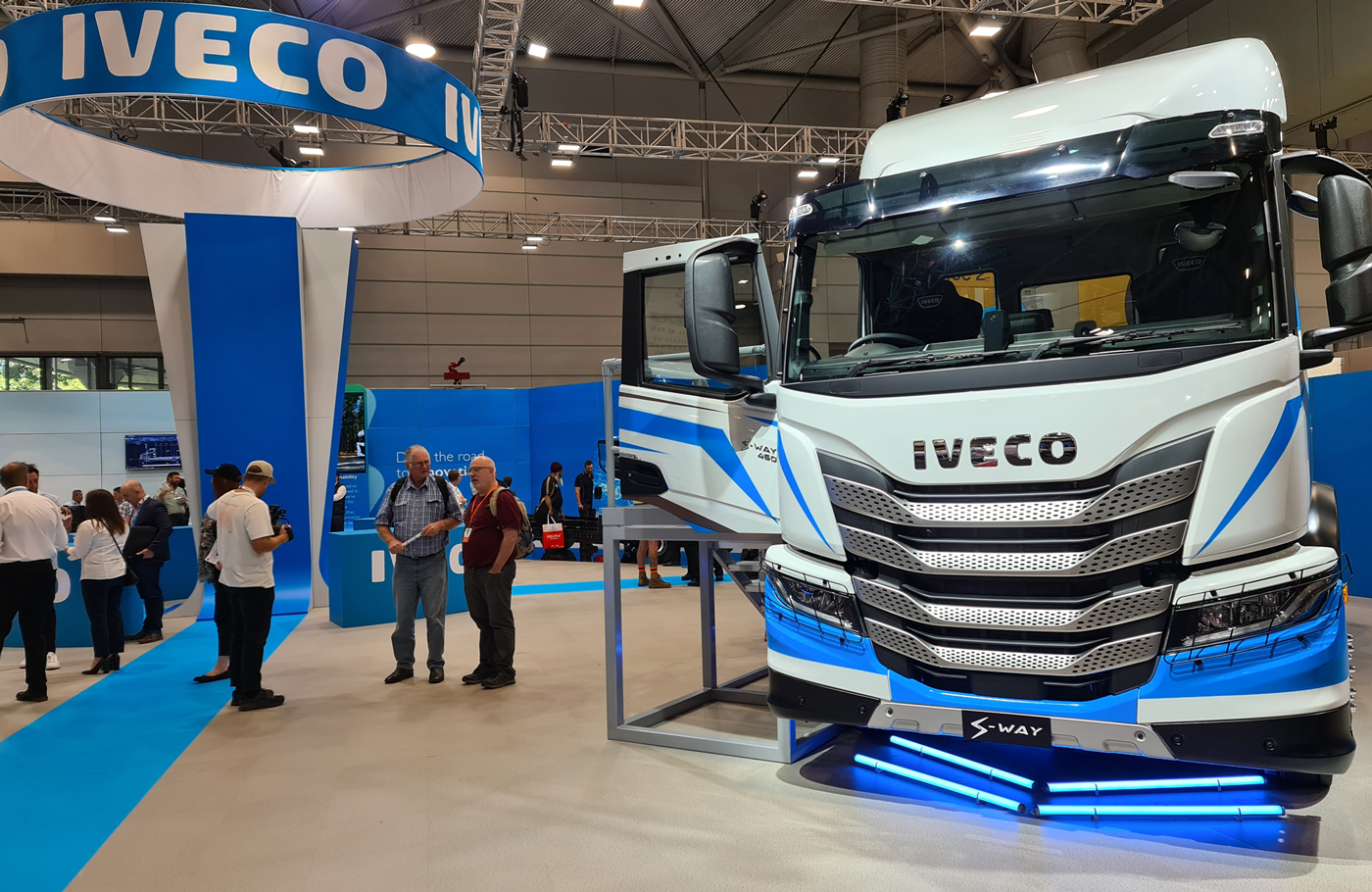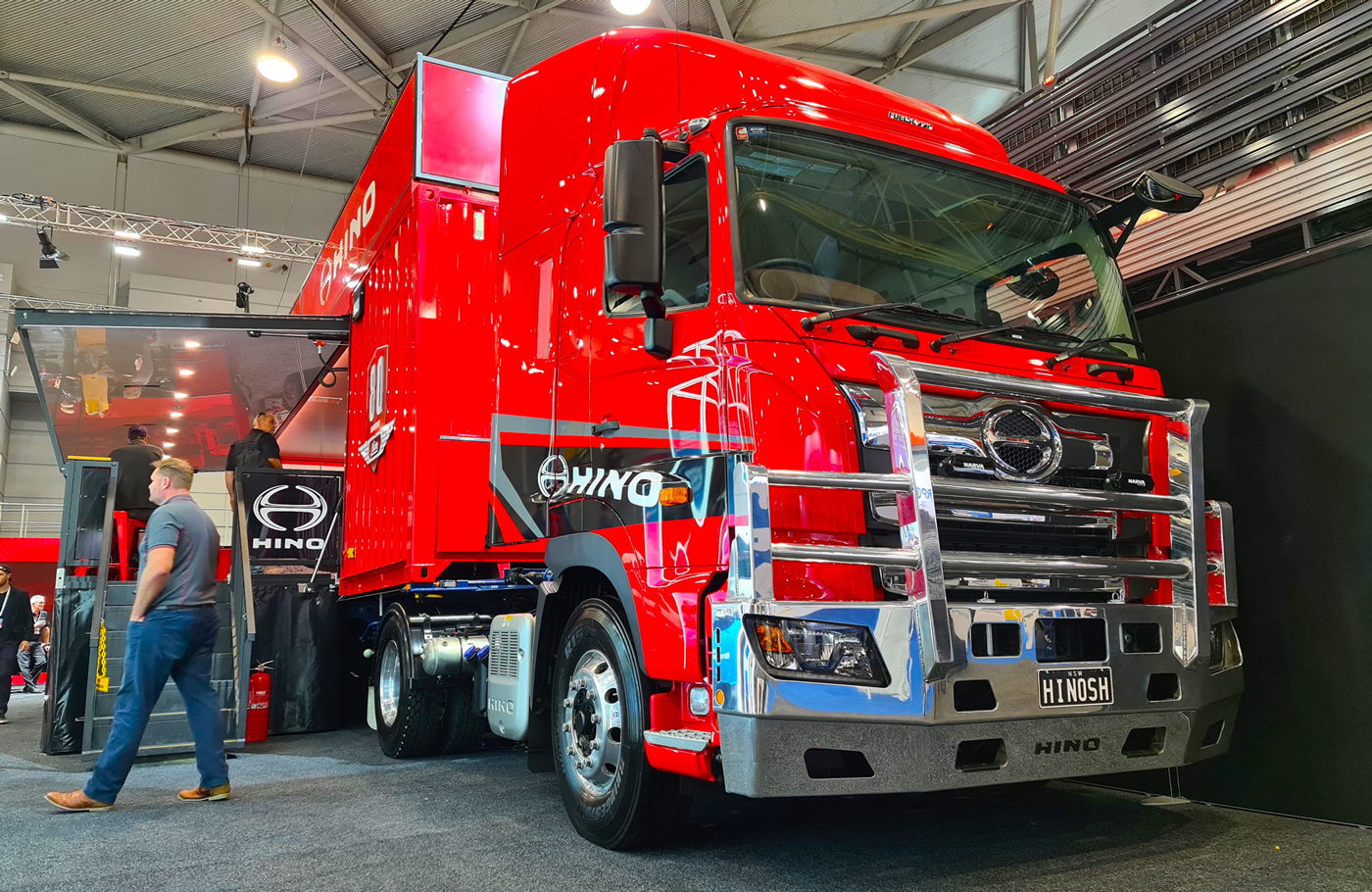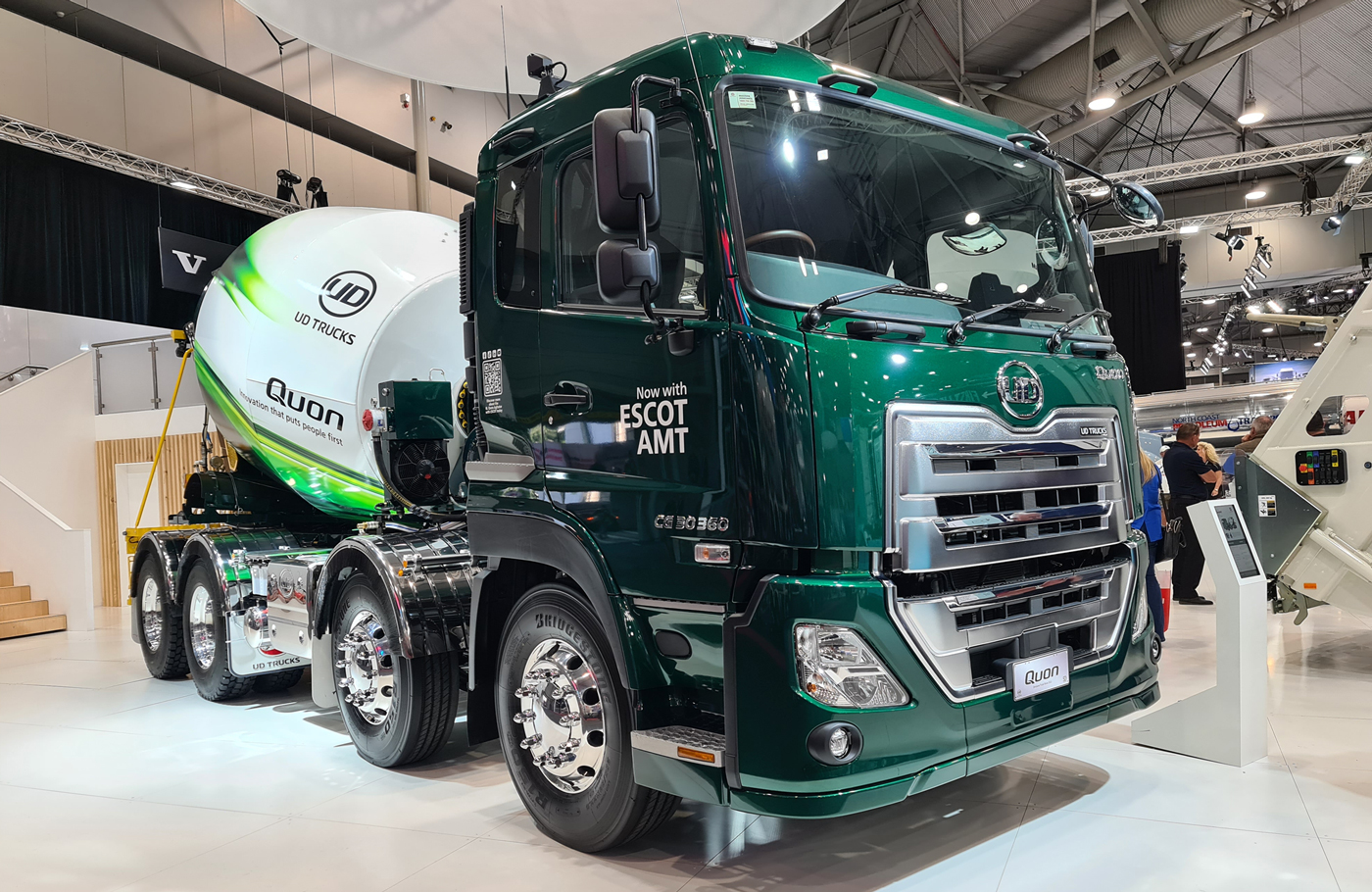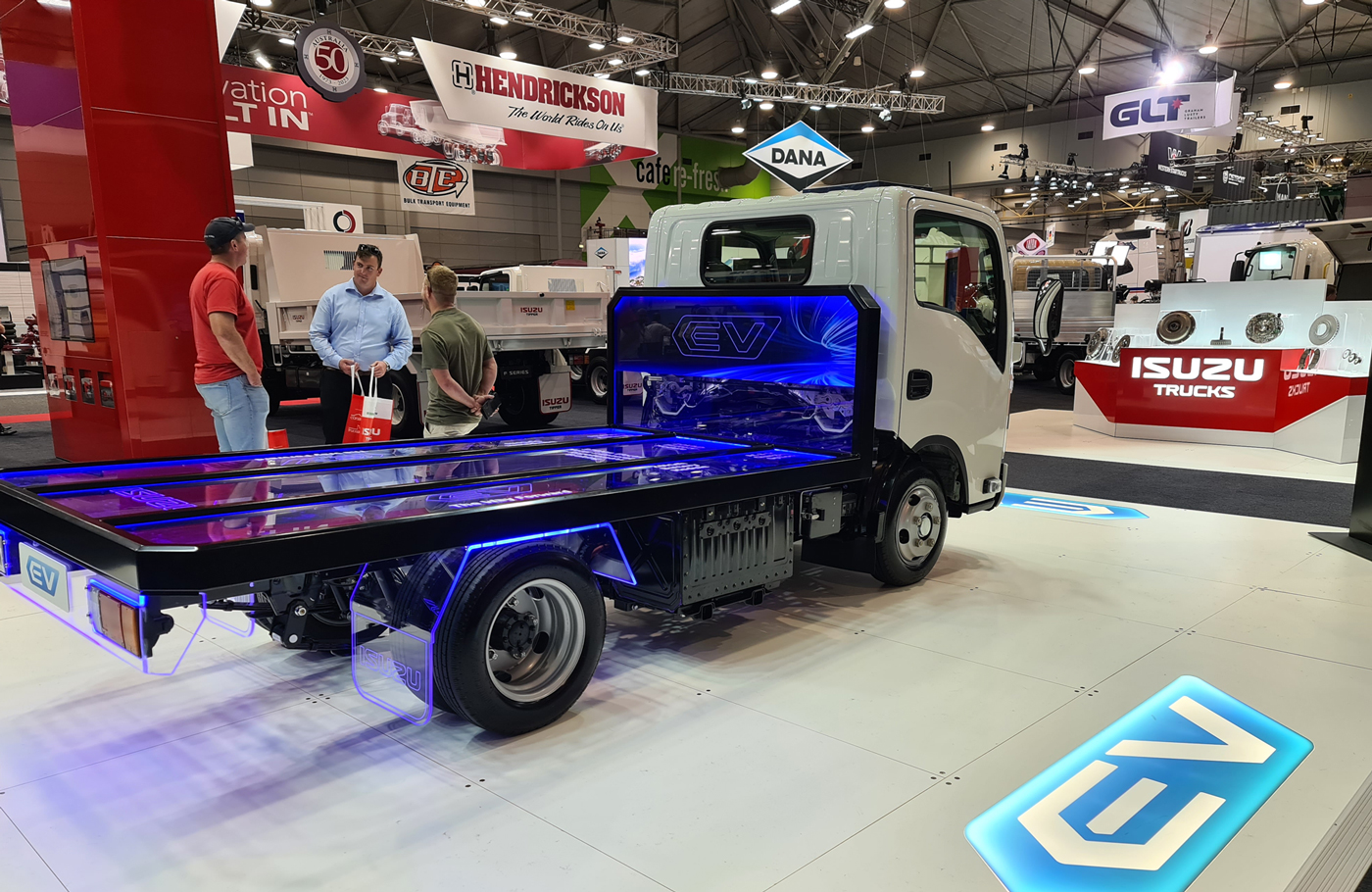Battery-electrics, big numbers, bonnets, and bling
Battery-electrics, big numbers, bonnets, and bling
There were three overriding themes at this year’s Brisbane Truck Show. On the one hand, lots of trucks with internal combustion engines, bonnets, and loads of bling were on display. On the other, there were many battery-electric vehicles on the stands – notably light and medium-duty trucks. In between all this, there was a celebration of significant milestones. CHARLEEN CLARKE attempted to take it all in.
Big, beautiful, bonneted trucks were everywhere, and many were chromed up to the max. It was a challenge to photograph them; visitors were crawling all over them and the Brisbane Truck Show doesn’t have a dedicated media day.
For me, Kenworth stole the show with its Heritage Series Legend SAR, which was displayed on the streets of Brisbane (the show wasn’t limited to the exhibition halls; there were public displays on the city’s streets, so members of the public could also admire the trucks without paying an entrance fee).
Getting back to that Legend SAR: what a truck! It’s a limited edition vehicle released back in 2021 to commemorate Kenworth’s 50 years of manufacturing trucks in Australia and sadly, they’ve all long been sold out.
The Legend SAR boasts a Cummins X15 engine, painted in beige to commemorate the heritage of the engine maker. This utterly magnificent truck was modelled on the iconic W900SAR (built and sold in Australia from 1975 until 1987) which was the first Kenworth model designed, engineered, and built in Australia specifically for Australian operating requirements. With its sloping bonnet and raised cab position, allowing for the first use of under-cab battery and toolboxes, the W900SAR (SAR standing for “short-bonnet Australian right-hand drive”) was a fusion of the W900AR and S2 models. Kenworth didn’t just display retro trucks; it also went on to win the inaugural Truck of the Year Australasia Award with its slap-bang up to date K220. Kenworth didn’t just display retro trucks; it also went on to win the inaugural Truck of the Year Australasia Award with its slap-bang up to date K220 (read more about that here).
Yet another bonneted truck that was well worth a second look was the Freightliner Cascadia Road Train (how we miss that brand in sunny South Africa…) on the Daimler stand. A top-of-the-range 126 Road Train – with a monster of a bullbar – was the star of the stand, with its mighty spacious
60-inch cab that is a real home away from home.
All 126 models feature the big 16-litre six-cylinder DD16 Detroit engine that pumps out up to 600hp and 2,050lb-ft (2,780Nm) of torque. It can be paired with a 12-speed Automated Manual Transmission (AMT) that is so smart it can use GPS and topographic data to help the truck maximise its coasting and pick the perfect gear for the terrain. Customers are also able to select an old-school 18-speed Eaton manual if they prefer.
Western Star’s all-new X-Series – launched in Australia in October last year – also caught our attention; the 47X, 48X, and 49X models were on display.




The 47X has a short, sloped bonnet that yields payload flexibility, a set-back front axle, and up to 72.5 tonnes GCM. It comes in either a 6×4 or 8×4 configuration and with the choice of Cummins or Detroit power under the hood.
Exclusive to the Australian market, the 48X is powered by the Detroit DD13 Gen 5 or DD16 engine. It has a CVM of over 130 tonnes and features a set-forward front axle. Furthermore, the 48X has a bumper-to-back-of-cab (BBC) measurement of 113 inches and comes with a choice of four sleeper cabins.
The 49X is powered by the Detroit DD16, has GCM capability of 200+ tonnes, and is available with multiple cabin options, including the largest cab on the Australian market, the 72-inch Stratosphere sleeper.
Cool cabovers
Cabover models were in ample supply too – and the Eye Candy Award had to go to Volvo’s magnificent FH16. It wasn’t just a good-looking truck, though; it was specially decalled to demonstrate the airflow over and around the cab. Of course, there were also electric trucks on the company’s stand. In Australasia, Volvo offers the FE Electric – a 225-kW rigid with a 200km range – as well as the 130-kW FL Electric, a medium-duty truck that offers 300km of range. Volvo intends to start building electric trucks at its Brisbane facility by 2027.
MAN is also now playing in the electric truck sandpit, with its glorious eTruck. That vehicle wasn’t on display in Brisbane (there are currently only a handful of prototypes on the planet). Instead, the company displayed MAN’s New Truck Generation – which we know very well in South Africa. On display at the Brisbane Truck Show were the 12-tonne GVM TGL powered by MAN’s 250-hp D08 SCR-only engine, the efficient and versatile 26-tonne GVM TGX powered by MAN’s 13-litre D26 engine, and the TGX 26.640 with MAN’s powerhouse 15-litre 640-hp engine, 26 tonnes GVM, and the super-spacious GX cab.
Yet another cabover-engine truck that drew the crowds was the all-new DAF XG+, scheduled for release in 2024. The big talking point was its 660-hp 15-litre Cummins engine, the X15D, which delivers a stonking 3,260Nm of torque. The truck is ideal for Australia’s growing A-double, B-triple, and high-utilisation B-double linehaul segments. While not displayed on the stand, the addition of Airglide suspension and Meritor axles to the final product will achieve a 97-tonne GVM with a light tare and axle mass distribution not synonymous with typical European cabovers available in the market. DAF claims that the truck – which will be built alongside Kenworth and existing DAF models in the PACCAR Australia Bayswater plant – will be the world’s most productive European truck.
UD Trucks showed its new eight-litre 360-hp Quon Agitator. UD’s line-up will now feature a new 6,400-mm/16-pallet wheelbase variant available for the increasingly popular Quon 8×4. A 16-pallet 6×4 solution has also been developed. The locally engineered wheelbase solution is based on the eight-litre 360-hp Quon and is available with either an Allison automatic or ESCOT automated transmission.
The Fuso Shogun 510 Tipper – the only Japanese tipper in the Australian market with more than 500hp – made its show debut in Brisbane. The Shogun 510 also delivers a productivity advantage, as it has the lightest tare weight of any tipper in Australia. The Shogun 510 was developed specifically for Australian and New Zealand customers who asked for an advanced Japanese truck with more than 500hp and a mountain of torque.
The truck features a 13-litre OM471 engine from the Daimler Truck family, which belts out 510hp and 2,500Nm of torque. It is matched to a smart-shifting DT12 fully Automated Manual Transmission (AMT).
The Hino stand showcased the two engine variants within the 700 Series range: an FY3036 8×4 cab chassis with an A09C nine-litre engine, and an E13C 13-litre SH1845 4×2 prime mover. The latter transports the Hino Sports Deck to various rounds of the Hino-sponsored Supercars Championship and the ongoing Hino Roadshow.
Enter e-mobility
The star of the Hino stand, however, was its Hybrid Electric 300 Series, which features the Hino N04C-WR four-cylinder common-rail injected turbodiesel engine. It produces 150hp (110kW) and 470Nm of torque, which is delivered in combination with the electric motor. Maximum torque is available at a very low 1,200r/min. Hino Australia reveals that recent real-world trials pitting the proven Hino Hybrid Electric truck against a traditional diesel equivalent revealed a 22% reduction in fuel use and CO2 emissions. Hybrid Electric customers also benefit from a 16% reduction in maintenance costs, the company reports.
Australian audiences also got their first glimpse of Iveco’s new fully electric eDaily. The show vehicle was a 70C cab chassis with a 4,350-mm wheelbase, 7.2 tonnes GVM, and three batteries; it is one of several models that will be tested locally in preparation for the roll-out of the broader eDaily line-up.
Mercedes-Benz showed its eEconic and eActros. Mercedes-Benz Trucks Australia will soon begin a local validation programme for both trucks.
Over on the Isuzu stand, e-mobility also came to the fore with the launch of Isuzu’s first-ever battery electric truck, the N Series EV, which is due to hit Australian shores very soon. The truck comes with various battery capacity options and the maximum range is said to be 378km. It will have an AC charging time of 5.5 to 10 hours and a DC fast charging time of one to 2.5 hours.
Fuso displayed its next generation eCanter for the first time in Australia. The original all-electric eCanter was launched in the country in 2021. As is the case all over the world, customers can now select from a variety of different wheelbases and weight ratings, plus they now have a choice of City Cab or Wide Cab. The introduction of an electric Power Take Off (PTO), meanwhile, opens up a raft of new possibilities, with the truck’s electric power now able to operate tipper bodies, cranes, or even a fridge body.
Not wanting to be left out of the e-mobility party, Hyundai showed its Mighty electric truck which, when it is launched in Australia on 1 July this year, will cost about AU$150,000 (that’s roughly an eye-watering R1,9 million) for a cab/chassis unit.
TruckScience's Martin Dammann was at the Brisbane Truck Show. He is pictured with Charleen Clarke from FOCUS.
This 4×2 light-duty heavy vehicle has a GVM of up to 7.3 tonnes and a payload of around four tonnes (including the tray or body structure). It has an estimated working AER (All Electric Range) of up to 200km when fully loaded and fully charged with the air-conditioning running. This figure has been validated by more than 5,000km of real-world testing in New South Wales, utilising a pre-production truck with a tray configuration.
The 120-kW/320-Nm electric motor is powered by a 114.5-kWh battery system, driving through a single-speed reduction gear transmission. When connected to an 800V ultra-rapid (DC) charger, the battery can be replenished from 8% to 100% in just 71 minutes.
Fuel cells to the fore
While e-mobility was extremely prominent, fuel cells also came to the fore. For instance, a company called Pure Hydrogen launched its 220-kW 6×4 HD49T hydrogen fuel cell prime mover, the Taurus. While not the first on the market, the company claims it will be the catalyst for future long haul trucking across Australia.
The Taurus is an Australian-designed model developed in partnership with ZEV company HDrive. It has a top speed of 100km/h and a range of 500km on a full tank of hydrogen.
Pure Hydrogen has already leased the truck to PepsiCo Australia; it will be used in Brisbane as a back-to-base truck, taking product from the factory to the distribution centre on a daily basis. The company believes it will be a stepping-stone to help PepsiCo decarbonise. Pure Hydrogen says it is taking orders from other new customers too.
Big numbers
Lots of milestones were celebrated at the Brisbane Truck Show. UD celebrated 50 years of doing business in Australia, while Mack Trucks Australia commemorated turning 60 with a display of iconic Bulldogs from each of the decades.
Daimler was championing 25 years of the Actros being in Australia. It launched the striking limited edition Actros 25 Driver Edition truck – based on the 16-litre 2663 Actros and featuring a dark grey metallic paint scheme – to mark the occasion.
BPW celebrated the production of its 300,000th axle in Australia: a 10 Stud 285 PCD Brake Drum axle. That was one of three milestones being lauded; BPW was also celebrating 125 years in business and 65 years of trading in Australia.
In keeping with the strong e-mobility theme at the show, BPW showed its ePower – a new axle module developed by the engineers at BPW in conjunction with Thermo King. It recovers energy from the moving trailer, enabling a carbon neutral and quiet supply of power to refrigeration units for temperature-controlled transport. Two generators are used to provide double the power and reliability. Intelligent energy management ensures that the cooling system always has access to sufficient battery reserves, even on long journeys or in traffic jams.
The ePower, which is the basis for the latest generation of refrigeration units from Thermo King, means that forthcoming vehicle bans and delivery restrictions can be avoided, resources can be conserved, and sustainability can be improved in the transport chain.
This super smart product, which can yield annual fuel savings of up to 4,000 litres per trailer depending on use and equipment, will be tested in South Africa in July this year.
Published by
Charleen Clarke
focusmagsa






